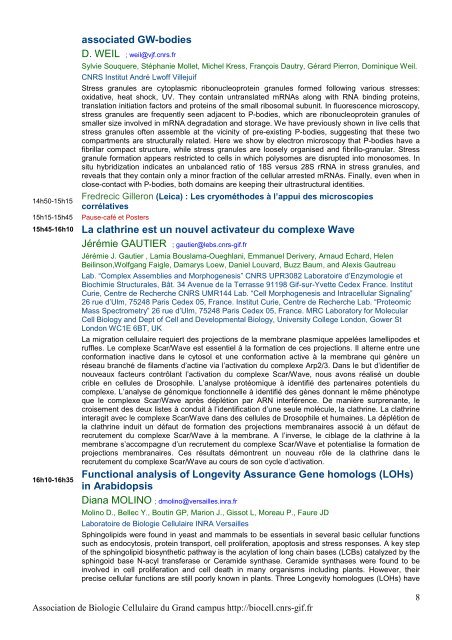Dynamique Cellulaire - Développement - Association de Biologie ...
Dynamique Cellulaire - Développement - Association de Biologie ...
Dynamique Cellulaire - Développement - Association de Biologie ...
You also want an ePaper? Increase the reach of your titles
YUMPU automatically turns print PDFs into web optimized ePapers that Google loves.
14h50-15h15<br />
associated GW-bodies<br />
D. WEIL ; weil@vjf.cnrs.fr<br />
Sylvie Souquere, Stéphanie Mollet, Michel Kress, François Dautry, Gérard Pierron, Dominique Weil.<br />
CNRS Institut André Lwoff Villejuif<br />
Stress granules are cytoplasmic ribonucleoprotein granules formed following various stresses:<br />
oxidative, heat shock, UV. They contain untranslated mRNAs along with RNA binding proteins,<br />
translation initiation factors and proteins of the small ribosomal subunit. In fluorescence microscopy,<br />
stress granules are frequently seen adjacent to P-bodies, which are ribonucleoprotein granules of<br />
smaller size involved in mRNA <strong>de</strong>gradation and storage. We have previously shown in live cells that<br />
stress granules often assemble at the vicinity of pre-existing P-bodies, suggesting that these two<br />
compartments are structurally related. Here we show by electron microscopy that P-bodies have a<br />
fibrillar compact structure, while stress granules are loosely organised and fibrillo-granular. Stress<br />
granule formation appears restricted to cells in which polysomes are disrupted into monosomes. In<br />
situ hybridization indicates an unbalanced ratio of 18S versus 28S rRNA in stress granules, and<br />
reveals that they contain only a minor fraction of the cellular arrested mRNAs. Finally, even when in<br />
close-contact with P-bodies, both domains are keeping their ultrastructural i<strong>de</strong>ntities.<br />
Fredrecic Gilleron (Leica) : Les cryométho<strong>de</strong>s à l’appui <strong>de</strong>s microscopies<br />
corrélatives<br />
15h15-15h45 Pause-café et Posters<br />
15h45-16h10 La clathrine est un nouvel activateur du complexe Wave<br />
16h10-16h35<br />
Jérémie GAUTIER ; gautier@lebs.cnrs-gif.fr<br />
Jérémie J. Gautier , Lamia Bouslama-Oueghlani, Emmanuel Derivery, Arnaud Echard, Helen<br />
Beilinson,Wolfgang Faigle, Damarys Loew, Daniel Louvard, Buzz Baum, and Alexis Gautreau<br />
Lab. “Complex Assemblies and Morphogenesis” CNRS UPR3082 Laboratoire d’Enzymologie et<br />
Biochimie Structurales, Bât. 34 Avenue <strong>de</strong> la Terrasse 91198 Gif-sur-Yvette Ce<strong>de</strong>x France. Institut<br />
Curie, Centre <strong>de</strong> Recherche CNRS UMR144 Lab. “Cell Morphogenesis and Intracellular Signaling”<br />
26 rue d’Ulm, 75248 Paris Ce<strong>de</strong>x 05, France. Institut Curie, Centre <strong>de</strong> Recherche Lab. “Proteomic<br />
Mass Spectrometry” 26 rue d’Ulm, 75248 Paris Ce<strong>de</strong>x 05, France. MRC Laboratory for Molecular<br />
Cell Biology and Dept of Cell and Developmental Biology, University College London, Gower St<br />
London WC1E 6BT, UK<br />
La migration cellulaire requiert <strong>de</strong>s projections <strong>de</strong> la membrane plasmique appelées lamellipo<strong>de</strong>s et<br />
ruffles. Le complexe Scar/Wave est essentiel à la formation <strong>de</strong> ces projections. Il alterne entre une<br />
conformation inactive dans le cytosol et une conformation active à la membrane qui génère un<br />
réseau branché <strong>de</strong> filaments d’actine via l’activation du complexe Arp2/3. Dans le but d’i<strong>de</strong>ntifier <strong>de</strong><br />
nouveaux facteurs contrôlant l’activation du complexe Scar/Wave, nous avons réalisé un double<br />
crible en cellules <strong>de</strong> Drosophile. L’analyse protéomique à i<strong>de</strong>ntifié <strong>de</strong>s partenaires potentiels du<br />
complexe. L’analyse <strong>de</strong> génomique fonctionnelle à i<strong>de</strong>ntifié <strong>de</strong>s gènes donnant le même phénotype<br />
que le complexe Scar/Wave après déplétion par ARN interférence. De manière surprenante, le<br />
croisement <strong>de</strong>s <strong>de</strong>ux listes à conduit à l’i<strong>de</strong>ntification d’une seule molécule, la clathrine. La clathrine<br />
interagit avec le complexe Scar/Wave dans <strong>de</strong>s cellules <strong>de</strong> Drosophile et humaines. La déplétion <strong>de</strong><br />
la clathrine induit un défaut <strong>de</strong> formation <strong>de</strong>s projections membranaires associé à un défaut <strong>de</strong><br />
recrutement du complexe Scar/Wave à la membrane. A l’inverse, le ciblage <strong>de</strong> la clathrine à la<br />
membrane s’accompagne d’un recrutement du complexe Scar/Wave et potentialise la formation <strong>de</strong><br />
projections membranaires. Ces résultats démontrent un nouveau rôle <strong>de</strong> la clathrine dans le<br />
recrutement du complexe Scar/Wave au cours <strong>de</strong> son cycle d’activation.<br />
Functional analysis of Longevity Assurance Gene homologs (LOHs)<br />
in Arabidopsis<br />
Diana MOLINO ; dmolino@versailles.inra.fr<br />
Molino D., Bellec Y., Boutin GP, Marion J., Gissot L, Moreau P., Faure JD<br />
Laboratoire <strong>de</strong> <strong>Biologie</strong> <strong>Cellulaire</strong> INRA Versailles<br />
Sphingolipids were found in yeast and mammals to be essentials in several basic cellular functions<br />
such as endocytosis, protein transport, cell proliferation, apoptosis and stress responses. A key step<br />
of the sphingolipid biosynthetic pathway is the acylation of long chain bases (LCBs) catalyzed by the<br />
sphingoid base N-acyl transferase or Cerami<strong>de</strong> synthase. Cerami<strong>de</strong> synthases were found to be<br />
involved in cell proliferation and cell <strong>de</strong>ath in many organisms including plants. However, their<br />
precise cellular functions are still poorly known in plants. Three Longevity homologues (LOHs) have<br />
<strong>Association</strong> <strong>de</strong> <strong>Biologie</strong> <strong>Cellulaire</strong> du Grand campus http://biocell.cnrs-gif.fr<br />
8


